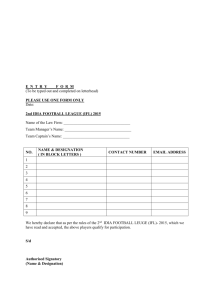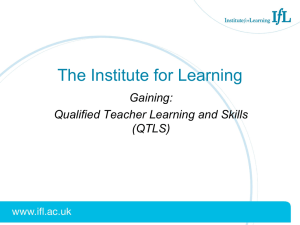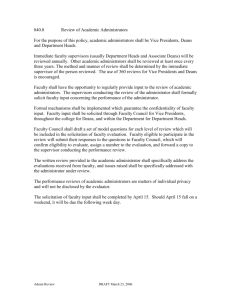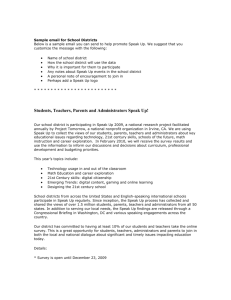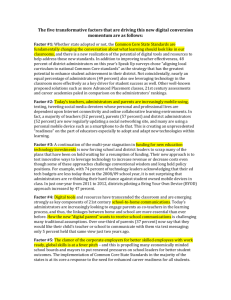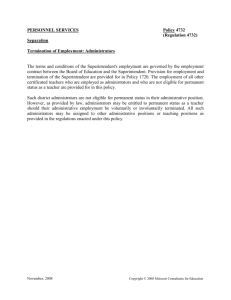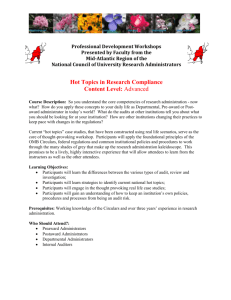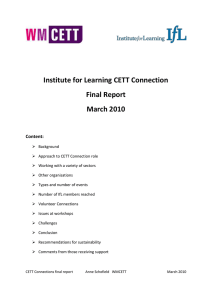In the name of learning, what are the leadership practices
advertisement
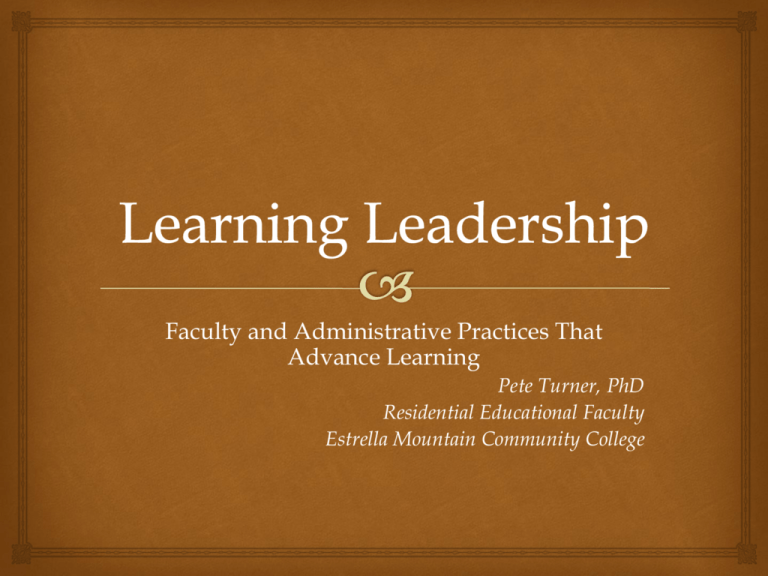
Faculty and Administrative Practices That Advance Learning Pete Turner, PhD Residential Educational Faculty Estrella Mountain Community College How Many of You are Faculty? Senior Administrators (Presidents or VicePresidents)? Deans or middle-level administrators? Support Staff? In the name of learning, what are the leadership characteristics and practices . . . Of effective faculty? Of effective administrators? Faculty Leadership Not Appointed Elected But Informal “Grassroots” (Burke, 2010; Kezar & Lester, 2009) Faculty members influencing their peers Amend and improve practices Name of student learning So What’s This About? Background Recommend Purpose Learning Leadership Lit Review Implications Findings Background Starts with Teacher Leadership • Most significant in reforming K-12 education (Danielson, 2006; Donaldson, 2006) • More responsible for bringing about change than any other force (Reeves, 2008) And what about informal (grassroots) faculty leadership (IFL)? • Essentially undefined, little documentation (Shugart, 2010; Turner, 2013; Wilson, 2010) • Calls for more research (Burke, Kezar & Lester) So . . . Led to research project Literature review Case Study involving Three of original Vanguard Colleges Documents examination Senior administrator (10+ yrs. at that college) interviews Faculty Surveys Purpose Determine current IFL practices, examples Explore future areas for IF leaders Identifying administrative practices advancing IFL Delineate administrative practices impeding IFL Literature Review Informal Faculty Leadership Formal vs. Informal (Burke, 2008; Kezar & Lester, 2009; Mayrowetz, 2008) IFL in the Learning College and Post-Secondary Education Collaborative teams (O’Banion, 2007; Shugart, 2010; Wilson, 2010) Faculty Inquiry Groups (Faculty, 2008; Huber, 2008) Grassroots leadership (Burke, 2010) – new technologies, new pedagogies Focus on teaching and learning (Shugart, 2010) Literature Review Administrative actions advancing IFL Supporting actions (Wechsler, 2007) Collaborative Narrow focus on teaching and learning, broad perspective of college High value for role of faculty in change All levels involved in innovation Servant leaders (Grosso, 2008) Literature Review Administrative actions impeding IFL Impeding actions (Kezar, 2009) Initiative overload “Institutional isomorphism” “Bureaucratic Baloney” (Reeves, 2008) Leaders don’t model behavior they preach “Polar opposite of culture of evidence” Traditions rule over data-driven decisions Reliance on purpose (as opposed to results) Findings Examination of Documents High level of consistency Common themes: Learning Collaboration Innovation Diversity Findings Faculty Member Surveys Current/future examples: Collaboration Mentoring (faculty-faculty, faculty-student) Center for Teaching and Learning Innovative ideas with sharing Findings Faculty Member Surveys Current/future examples: Action research Service learning Technology Faculty-driven professional development Findings Faculty Member Surveys Administrative Practices Advancing: Characteristics of administrators Facilitative, encouraging, communication, trust, transparency Collaborative: horizontal and vertical Allocation of resources (CTL, technology, etc.) High value for faculty innovators Provide needs and then freedom “Get me what I need then get out of the way!” Findings Faculty Member Surveys Administrative Practices Hindering: Character deficits Micromanaging Secretive, lack of transparency Poor communication skills Collaboration deficit, especially horizontal Failure to show appreciation/recognition Organizational design issues Structural designs, campus layout Not supporting innovation Not allocating resources Findings Faculty Member Surveys Administrative Practices Hindering: Requirements not related to teaching/learning Paperwork Out-of-class assignments, tasks Committee assignments not related to learning Impediments to collaboration Not modelling Not walking talk Not removing structural roadblock Role of deans, other middle-level managers Findings Administrator Interviews Current/future examples Characteristics of IF Leaders Focused on learning Energetic, enthusiastic: “passionate innovators” Never satisfied, always looking for better way Influential: always sharing and contributing Purveyors of innovative practices Service learning Experiential learning Authentic assessment High engagement pedagogies Use of cutting edge technology High value for informal faculty leaders – aura of mutual admiration Findings Administrator Interviews Administrative practices advancing Characteristics of administrators Self-critical, open to change Focus on learning Culture of collaboration Inclusive of faculty in discussions, decisions Deep conversations Open to suggestions Continual, rigorous, transparent system to evaluate current systems/practices High value for informal faculty leaders Findings Administrator Interviews Administrative practices advancing Facilitative Dedication of budget, resources Ongoing faculty development, faculty involvement Moving innovation to institutionalization Hiring consistent with learning Peer-to-peer training Induction/mentoring program Celebration of IFL Findings Administrator Interviews Administrative practices/structures hindering Financial stressors Governance systems, political agendas Middle level managers (deans, etc.) Enrollment first Budget second Learning third Environmental obstructs Speaking of enrollment . . . Implications Derived from Convergence High value held for IFL and leaders: significant/necessary vehicles for change Continual focus on learning, collaboration, innovation Programs: Service Learning Mentoring CTL/faculty-driven professional development Emerging technologies Deans/middle level managers focused on learning Recommendations Regarding Professional Development Administrators Provide resources Let faculty drive it Faculty members Understand importance of PD Share best practices Strive for continual growth Recommendations Regarding Programs (Service Learning, Mentoring, Emerging Technologies) Administrators Well-resourced and supported? Move to more integrated and essential part? Faculty have critical role in driving/implementing? Faculty members Be open to change Understand connection of change to learning Recommendations Regarding Administrative Practices Challenges in moving innovation to institutionalization Faculty used as “champion innovators”? If perceived as top-down Dedicate the resources Faculty members Understand processes, protocols to be followed Understand challenges admin faces So What’s This About? Background Recommend Purpose Learning Leadership Lit Review Implications Findings So now, in the name of learning, what are the leadership characteristics and practices . . . Of effective faculty? Of effective administrators? References Burke, K. (2010). Distributed leadership and shared governance in post secondary education. Management in Education 24(2), 51-54. Retrieved from: http://mie.sagepub.com.proxy1.ncu.edu/content/24/2/51.abstract Danielson, C. (2006). Teacher leadership that strengthens professional practice. Alexandria, VA: Association for Supervision and Curriculum Development. Donaldson, G.A. Jr. (2006). Cultivating leadership in schools: Connecting people, purpose, and practice. New York: Teachers College. Faculty inquiry in action: Guidelines for working together to improve student learning (2008). The Carnegie Foundation for the advancement of teaching. Retrieved from: http://www.carnegiefoundation.org/publications/faculty-inquiry-action-guidelines-workingtogether-improve-student-learning. Grosso, F.A. (2008). Motivating faculty through transformational leadership: A study of the Relationship between presidential leadership behaviors and faculty behaviors. Dissertation, The Catholic University of America, # 3310021. References Huber, M.T. (2008). The promise of faculty inquiry for teaching and learning basic skills. A Report from the Carnegie Foundation for the Advancement of Teaching: Strengthening Pre-Collegiate Education in Community Colleges. Retrieved from: http://eric.ed.gov/PDFS/ED503130.pdf. Kezar, A. (2009). Change in higher education: Not enough or too much? Change: The Magazine of Higher Learning 32(6), 18-23. Kezar, A., Lester, J. (2009). Supporting faculty grassroots leadership. Research in Higher Education 50, 715740. DOI 10.1007/s11162-009-9139-6. Mayrowetz, D. (2008). Making sense of distributed leadership: Exploring the multiple usages of the concept in the field. Educational and Administration Quarterly 44(3), 424-435. O'Banion, T. (2007). Leadership for learning. Community College Journal, 78(2), 45-47. Retrieved from Research Library. (Document ID: 1383351301). References Reeves, D. B. (2008). Reframing teacher leadership to improve your school. Alexandria, VA: Association for Supervision and Curriculum Development. Shugart, S. (January 8, 2010). From an interview with the president of Valencia College (a Vanguard College) conducted by Peter Turner, Doctoral candidate, Northcentral University; at Estrella Mountain Community College, Avondale, Arizona. Turner, P. (2013). Informal faculty leadership that transforms: Evidences and practices for the Learning College. Dissertation, Northcentral University. UMI # 3571494 Wechsler, J.K. (2007). The presidents’ role in the learning college project: A multiple case study. Abstract of Dissertation, Argosy University. Wilson, C. (August 23, 2010). From a telephone interview conducted by Peter Turner, Doctoral candidate, Northcentral University; and Learning College Project Director at the League for Innovation in the Community College.
